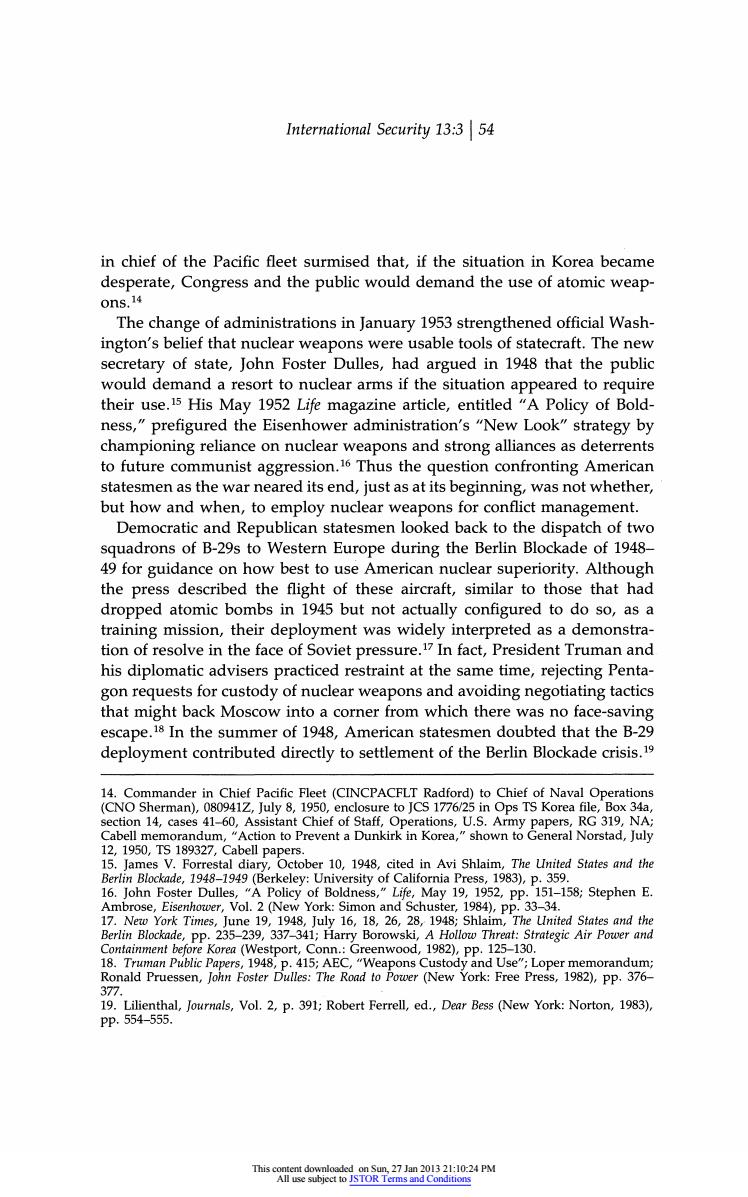正在加载图片...

International Security 13:354 in chief of the Pacific fleet surmised that,if the situation in Korea became desperate,Congress and the public would demand the use of atomic weap- 0ns.14 The change of administrations in January 1953 strengthened official Wash- ington's belief that nuclear weapons were usable tools of statecraft.The new secretary of state,John Foster Dulles,had argued in 1948 that the public would demand a resort to nuclear arms if the situation appeared to require their use.15 His May 1952 Life magazine article,entitled "A Policy of Bold- ness,"prefigured the Eisenhower administration's "New Look"strategy by championing reliance on nuclear weapons and strong alliances as deterrents to future communist aggression.16 Thus the question confronting American statesmen as the war neared its end,just as at its beginning,was not whether, but how and when,to employ nuclear weapons for conflict management. Democratic and Republican statesmen looked back to the dispatch of two squadrons of B-29s to Western Europe during the Berlin Blockade of 1948- 49 for guidance on how best to use American nuclear superiority.Although the press described the flight of these aircraft,similar to those that had dropped atomic bombs in 1945 but not actually configured to do so,as a training mission,their deployment was widely interpreted as a demonstra- tion of resolve in the face of Soviet pressure.17 In fact,President Truman and his diplomatic advisers practiced restraint at the same time,rejecting Penta- gon requests for custody of nuclear weapons and avoiding negotiating tactics that might back Moscow into a corner from which there was no face-saving escape.18 In the summer of 1948,American statesmen doubted that the B-29 deployment contributed directly to settlement of the Berlin Blockade crisis.19 14.Commander in Chief Pacific Fleet(CINCPACFLT Radford)to Chief of Naval Operations (CNO Sherman),080941Z,July 8,1950,enclosure to JCS 1776/25 in Ops TS Korea file,Box 34a, section 14,cases 41-60,Assistant Chief of Staff,Operations,U.S.Army papers,RG 319,NA; Cabell memorandum,"Action to Prevent a Dunkirk in Korea,shown to General Norstad,July 12,1950,TS 189327,Cabell papers. 15.James V.Forrestal diary,October 10,1948,cited in Avi Shlaim,The United States and the Berlin Blockade,1948-1949 (Berkeley:University of California Press,1983),p.359. 16.John Foster Dulles,"A Policy of Boldness,"Life,May 19,1952,pp.151-158;Stephen E. Ambrose,Eisenhower,Vol.2 (New York:Simon and Schuster,1984),pp.33-34. 17.New York Times,June 19,1948,July 16,18,26,28,1948;Shlaim,The United States and the Berlin Blockade,pp.235-239,337-341;Harry Borowski,A Hollow Threat:Strategic Air Power and Containment before Korea (Westport,Conn.:Greenwood,1982),pp.125-130. 18.Truman Public Papers,1948,p.415;AEC,"Weapons Custody and Use";Loper memorandum; Ronald Pruessen,John Foster Dulles:The Road to Power (New York:Free Press,1982),pp.376- 377. 19.Lilienthal,Journals,Vol.2,p.391;Robert Ferrell,ed.,Dear Bess (New York:Norton,1983), Pp.554-555. This content downloaded on Sun,27 Jan 2013 21:10:24 PM All use subject to JSTOR Terms and ConditionsInternational Security 13:3 j 54 in chief of the Pacific fleet surmised that, if the situation in Korea became desperate, Congress and the public would demand the use of atomic weapons. 14 The change of administrations in January 1953 strengthened official Washington's belief that nuclear weapons were usable tools of statecraft. The new secretary of state, John Foster Dulles, had argued in 1948 that the public would demand a resort to nuclear arms if the situation appeared to require their use.15 His May 1952 Life magazine article, entitled "A Policy of Boldness," prefigured the Eisenhower administration's "New Look" strategy by championing reliance on nuclear weapons and strong alliances as deterrents to future communist aggression.16 Thus the question confronting American statesmen as the war neared its end, just as at its beginning, was not whether, but how and when, to employ nuclear weapons for conflict management. Democratic and Republican statesmen looked back to the dispatch of two squadrons of B-29s to Western Europe during the Berlin Blockade of 1948- 49 for guidance on how best to use American nuclear superiority. Although the press described the flight of these aircraft, similar to those that had dropped atomic bombs in 1945 but not actually configured to do so, as a training mission, their deployment was widely interpreted as a demonstration of resolve in the face of Soviet pressure.17 In fact, President Truman and his diplomatic advisers practiced restraint at the same time, rejecting Pentagon requests for custody of nuclear weapons and avoiding negotiating tactics that might back Moscow into a corner from which there was no face-saving escape.18 In the summer of 1948, American statesmen doubted that the B-29 deployment contributed directly to settlement of the Berlin Blockade crisis.19 14. Commander in Chief Pacific Fleet (CINCPACFLT Radford) to Chief of Naval Operations (CNO Sherman), 080941Z, July 8, 1950, enclosure to JCS 1776/25 in Ops TS Korea file, Box 34a, section 14, cases 41-60, Assistant Chief of Staff, Operations, U.S. Army papers, RG 319, NA; Cabell memorandum, "Action to Prevent a Dunkirk in Korea," shown to General Norstad, July 12, 1950, TS 189327, Cabell papers. 15. James V. Forrestal diary, October 10, 1948, cited in Avi Shlaim, The United States and the Berlin Blockade, 1948-1949 (Berkeley: University of California Press, 1983), p. 359. 16. John Foster Dulles, "A Policy of Boldness," Life, May 19, 1952, pp. 151-158; Stephen E. Ambrose, Eisenhower, Vol. 2 (New York: Simon and Schuster, 1984), pp. 33-34. 17. New York Times, June 19, 1948, July 16, 18, 26, 28,- 1948; Shlaim, The United States and the Berlin Blockade, pp. 235-239, 337-341; Harry Borowski, A Hollow Threat: Strategic Air Power and Containment before Korea (Westport, Conn.: Greenwood, 1982), pp. 125-130. 18. Truman Public Papers, 1948, p. 415; AEC, "Weapons Custody and Use"; Loper memorandum; Ronald Pruessen, John Foster Dulles: The Road to Power (New York: Free Press, 1982), pp. 376- 377. 19. Lilienthal, Journals, Vol. 2, p. 391; Robert Ferrell, ed., Dear Bess (New York: Norton, 1983), pp. 554-555. This content downloaded on Sun, 27 Jan 2013 21:10:24 PM All use subject to JSTOR Terms and Conditions